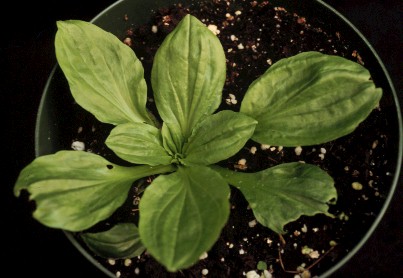

Plantain
Plantago major
Blooms May through October
Perennial alien
This common perennial sports 3 to 7 rough-looking greenish-white to brown
flower/seed spikes arising
from a basal rosette of thick bright green leaves with parallel veins.
The glabrous leaves are 4" to 8" long on 4" to 6" petioles, which are stiff
and grooved, and sometimes hairy toward the base. Leaf margins are
entire to slightly dentate and rough the touch.
The flower stalks are 6' to 18" long with tiny hairs, 1/4" to 3/8" thick, and rise fairly straight up from the leafy base. The 1/8" flowers are greenish-white with a purplish cast, but appear brownish due to the coloring of the bracts and sepals. Brownish-purple seed capsules soon replace the flowers. The root is shallow and fibrous. Plantain is found almost everywhere throughout the U.S. where soil is fertile and somewhat compacted.
It first came to us via the Europeans, who seemed to leave the plant growing wherever they traveled. Thus Native Americans called it "white man's foot" and immediately set out to discover its uses. Most people know plantain by the name of "psyllium." Plantago psyllium provides the seeds for many over-the-counter laxative preparations, like Metamucil ®. Other species of plantain are also used commercially for varied medical purposes, since all have the same basic healing properties.
An infusion of the seeds has been used for all respiratory troubles including
coughs, hoarseness, and mucus congestion, and for its appetite-suppressing
properties. The infusion is also a treatment for gastroenteritis,
worms, and general feebleness. Externally, the juice of the fresh leaves,
or plantain salve, has been used for poisonous snake and insect bites.
But just to make sure, Native Americans often carried a small bag filled
with the powdered root as a charm against snakebite. A fresh leaf poultice
is used for abrasions, wounds, insect stings, blisters, swellings and inflammations,
sores and ulcers, burns rheumatism, and sore, tired feet.
-------------------------------------
Photo courtesy of Virginia Tech Weed Indentification Guide http://www.ppws.vt.edu/weedindex.htm
<--back
<--index